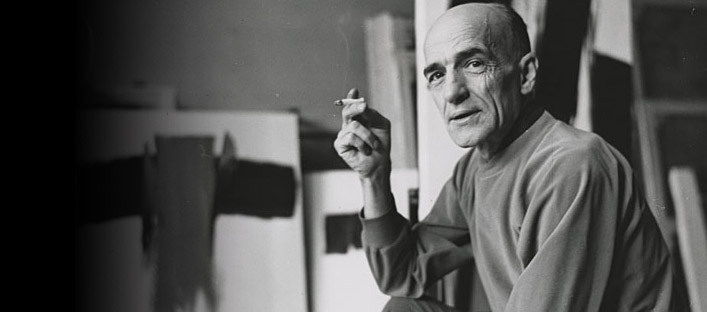In the House of Paul-Émile Borduas

Looking Back
The Impact of his Art
Borduas was able to continuously push back the boundaries of Canadian art and move it towards modernity. While initially ignored and denigrated by many, his production has taken its place among the most advanced and dynamic work in the history of 20th-century art. His pictorial exploration opened the way for painting as an abstract expression that was utterly subjective and individual. His painting embodied the notion of automatic writing based on research on the subconscious, as elaborated and described by André Breton and the Surrealists. Borduas went further, applying the concept to Automatist pictorial production. The work of Borduas and the Automatists differs from that of the European Surrealists, since they quite soon developed their own ways and followed paths that distanced them from Breton’s proposals.
From the 1940s onward, the Québec art world and Québec society were marked by Borduas’ work. Numerous exhibitions brought attention to Paul-Émile Borduas and his work in the United States and Europe both during his lifetime and long after his death. Although he was less well known in English Canada, this changed in the 1970s, when the federal government acquired the Borduas archives and presented a travelling exhibition that toured the entire country. Tributes to the man and the artist have never ceased since then.
Header image: Portrait of Paul-Émile Borduas.
Concerning today’s Surrealism, Borduas writes:
«The Surrealists have shown us the moral importance of the non-preconceived act.
Spontaneously, they put emphasis on “objective chance” as taking precedence over rational value. Their intentions have not changed.
However, these stated opinions have for several years now been increasingly affected by the attention given to the author’s intentions. Such attention has become much more dominant than that accorded to the “compulsive” quality of a work.
This has led to repeated errors, unknown in the empirical phase.
Intention is necessary, but not sufficient.
It is an impossibility to distinguish living, inevitable intention from false intention – an appropriated, affected, calculated and self-interested attitude.
The quality of being “convulsive” can only be the result of a magical operation, expressing an unforeseeable material relationship.
All the rest is relative, interesting and necessary, but not sufficient.
If when looking at this drawing, I have the moral certitude that I am standing before a work by Mousseau, it is definitely not because of such and such an intention on the part of the artist. This intention is still unknown to me for the most part! If I have the certitude that I am standing before a Mousseau, it is because of a non-intentional plastic relationship, inevitable and constant with Mousseau, which my memory brings back to me as something unique belonging to all the objects he fashions.
If I recognize such and such a watercolour as being by Riopelle (such as an example from one of the recent exhibitions), it is not because of the means used – the volumes, light, movement, material and colours (these means have changed little over time) – but uniquely because of a plastic relationship that is as involuntary and unique to Riopelle as the character of his senses and his mind.
It is here that all the convulsive, transformative power resides.
It is this power that has been lost by the best-known artists of our time through the conscious exploitation of their personalities.
Breton alone remains incorruptible.»
PAUL-EMILE BORDUAS
© Musée des beaux-arts de Mont-Saint-Hilaire, 2014.
All rights reserved.

